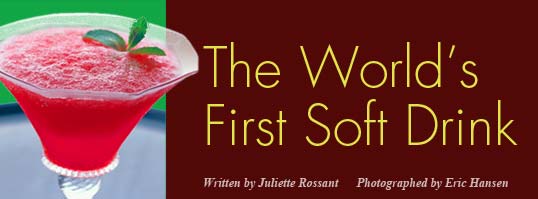

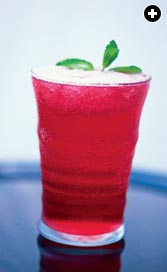 |
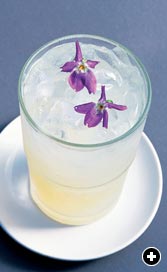 |
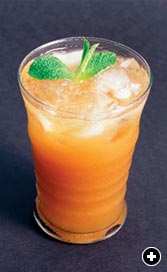 |
| From top: Pomegranate (with mint), violet and unfiltered tamarind sherbets. |
 o wrote Lord Byron longingly in 1813, after he had tasted the drink during visits to Istanbul.
o wrote Lord Byron longingly in 1813, after he had tasted the drink during visits to Istanbul.
In The Thousand and One Nights, sherbet appears as a refreshing and medicinal drink. Sir Richard Burton’s translation reads:
Thereupon Shahryar summoned doctors and surgeons and bade them treat his brother according to the rules of art, which they did for a whole month; but their sherbets and potions naught availed….
The drink known as sherbet has, in its various forms, inspired many imbibers with its intense, distilled fragrance of fruits, flowers or herbs. Both today and historically, sherbet is perhaps the most widespread drink in the Muslim world. Two centuries before Byron, the philosopher Francis Bacon had tasted sherbet in 1626, giving us one of the earliest records of the new English word.
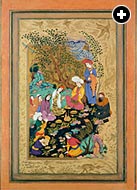 |
A 1612 painting by Riza-i Abbasi titled "A Convivial Party" shows the picnic fare, including tall ewers often used for sherbets.
state hermitage museum |
Sherbet is made from fruit juices or extracts of flowers or herbs, combined with sugar and water (and sometimes vinegar) to form a syrup that is thinned at any later time with water, ice or even snow. As alcohol is forbidden in Islam, sherbet became one of the most important beverages in Muslim cultures—even part of everyday language. In Egyptian Arabic, for example, “dammu sharbaat” (“his blood is sherbet”) is a compliment to a sweet disposition. Children are “sharbaataat”—“cuties” or “sweethearts.” Coffee or tea can be served “sharbaat,” which means “very sweet.” In Central and South Asia, sharbat is used as a given name, and one of National Geographic magazine’s most famous cover photographs is the face of Sharbat Gula of Afghanistan.
The reason for sherbet’s wide popularity was simply that, until the early 20th century, there were few means of preserving and transporting fresh fruit. Refrigeration was available only to the very rich, while the horse was the universal measure of both speed and distance. Fruits thus remained seasonal and local—except when they could be either dried or reduced to a liquid essence in the form of syrup.
 herbet derives from Arabic shariba, “to drink.” Shariba gave rise to numerous derivatives, in Arabic and other languages, including English. Whatever it was called in any language, however, sherbet’s principal meaning remains “syrup” or its derivative, “a cooling drink (of the East),” as the Oxford English Dictionary calls it.
herbet derives from Arabic shariba, “to drink.” Shariba gave rise to numerous derivatives, in Arabic and other languages, including English. Whatever it was called in any language, however, sherbet’s principal meaning remains “syrup” or its derivative, “a cooling drink (of the East),” as the Oxford English Dictionary calls it.
One variant, Arabic sharbah (essentially “a drink”), gave Turkish şerbet (and Persian and Hindi sharbat) and our sherbet. Another, shurb (literally “a drinking”), followed trading ships back west with Portuguese xarope, giving Medieval Latin sirupus and our own rather Greek-looking syrup. More recently, sharaab came west from India and by 1867 had entered such dictionaries as Smith’s Sailor’s Wordbook, which lists “Shrab, a vile drugged drink prepared for seaman who frequent the filthy purlieus of Calcutta.” The spelling in the American colonies crystallized as shrub.
Let us not forget another of sharaab’s contributions to language, this time in architecture: mashrabiyyah. According to A Dictionary of Egyptian Arabic, the word that now commonly refers to a Middle Eastern turned, latticed woodwork window screen applied originally to the location where that screen was placed: A mashrabiyyah is a platform projecting outside a house window, where jars could be stored and cooled by evaporation.
Ottoman Turks drank şerbet before and during each meal, and to this very day the Haci Abdullah restaurant in Istanbul’s Beyoğlu district serves şerbet with many traditional Ottoman foods. Customers can start a meal the old way, with a şerbet called karışık komposto, a dense, rose-colored drink made from syrup of quince, apple, pear, peach and apricot mixed with iced spring water.
Besides Haci Abdullah there are only a handful of restaurants which still serve Ottoman style, including Konyalı at the Topkapı Palace and Daruzziyafe (“guesthouse”) at the Süleymaniye Mosque, both in old Istanbul. According to the season, Daruzziyafe serves two kinds of şerbet each day: fruit—including pear, quince, strawberry, apple, cornelian cherry, pomegranate and orange—and herb şerbet made from the leaves or roots of such plants as palmyra palm, rose and carob. There is also a honey şerbet.
 n the New World, in McLean, Virginia, outside Washington, D.C., one can taste modern interpretations of Ottoman dishes at Kazan restaurant, run by Chef Zeynel Abidin Uzun, a student of Konyalı’s Ottoman-trained master chef Abdullah Effendi. Chef Uzun serves düğün şerbetı (“wedding sherbet”), a latter-day name for the Ottoman karışık komposto.
n the New World, in McLean, Virginia, outside Washington, D.C., one can taste modern interpretations of Ottoman dishes at Kazan restaurant, run by Chef Zeynel Abidin Uzun, a student of Konyalı’s Ottoman-trained master chef Abdullah Effendi. Chef Uzun serves düğün şerbetı (“wedding sherbet”), a latter-day name for the Ottoman karışık komposto.

Andrew Mango, former BBC director for the Near East and author of numerous books on Turkey, was raised in Istanbul. Of his youth in the early days of modern Turkey, Mango recollects there were şerbetçiler, or şerbet-sellers, who carried on their backs huge brass flasks with long spouts, filled with one of many flavors: tamarind or pomegranate, lemon or orange. Slung around his waist, the şerbetçi would carry a row of glasses tucked into his sash or into a brass cup-holder. For a customer, he would rinse a glass with water, bend forward and, from the spout that curved over his shoulder, pour delicious şerbet into the glass. There were also street-side stands that sold şerbet, which Mango recalls as “safer” in terms of cleanliness. Mango’s favorite şerbet flavors? They were kızılcık, or cornelian cherry, and demirhindi, or tamarind.
In villages in eastern Turkey, it is still true today that, after a dowry is agreed on, the groom’s family comes to the bride’s house and out comes a long-spouted brass or copper ewer, called an ibrik, filled with gül şerbeti, or rose sherbet. The woman who has “drunk sherbet” has accepted the groom’s suit. Far across Asia, in India and Afghanistan as well, once the groom’s family has offered presents, the bride’s family reciprocates by offering gol sharbat.
Not only marriage but also births and circumcisions demand sherbet. “As for special occasions, you should soon be offering loğusa şerbeti, a colored şerbet flavored with cloves and other spices, which is offered to visitors after the birth of a child,” recounts Mango. In Egypt, one is served finjan erfeh when visiting a newborn child.
In his 1836 classic Manners and Customs of the Modern Egyptians, Edward W. Lane described at length the sharaab of Egypt:
The Egyptians have various kinds of sherbets or sweet drinks. The most common kind is merely sugar and water but very sweet; lemonade is another; a third kind, the most esteemed, is prepared from a hard conserve of violets, made by pounding violet-flowers and then boiling them with sugar. This violet-sherbet is of a green color. A fourth kind is prepared from mulberries; a fifth from sorrel. There is also a kind of sherbet sold in the streets which is a strong infusion of liquorice-root, and called by the name of that root; a third kind, which is prepared from the fruit of the locust tree, and called in like manner by the name of the fruit.
 |
| Rose and lemon-zest sherbet, made from an infusion of rose petals, lemon zest and sugar syrup. |
The sherbet is served in coloured glass cups, generally called kullehs containing about three quarters of a pint, some of which (the more common kind) are ornamented with gilt flowers etc. The sherbet cups are placed on a round tray and covered with a piece of embroidered silk, or cloth of gold.
Sharaab was also served to end each day’s fasting during the month of Ramadan, Lane observed:
In general during Ramadan, in the houses of persons of the higher and middle classes, the stool of the supper-tray is placed in the apartment in which the master of the house receives his visitors a few minutes before sunset…. With these are also placed several kullehs (or glass cups) of sherbet of sugar and water—usually one or two more cups than there are persons in the house to partake of beverages in case of visitors coming unexpectedly…. Immediately after the call to evening-prayer, which is chanted four minutes after sunset, the master and such of his family or friends as happen to be with him drink each a glass of sherbet.
One such recipe served to this day in the United Arab Emirates is sharab loomi ma ward, or lemon sherbet with rosewater.
M. R. Ghanoonparvar, professor of Persian language and literature and an accomplished chef and cookbook author, recalls that in Iran, sharbat is usually served at parties, especially in summer, and often in special glasses.
 |
| Rangpur lime and orange-blossom sherbet. |
 n Iran, sharbat is often made from aromatic flowers rather than just fruit, mostly in Shiraz, which produces and exports to other parts of Iran those flower extracts (called ‘araq—literally “perspiration”). Some of the flowers are bahar narenj (orange blossoms), bidmeshk (Egyptian or musk-willow) and kâsnî (chicory). In her novel Savushun, the first written and published in Iran by a woman, Simin Daneshvar wrote of “the [sharbat] distillery next door with its mounds of flowers and herbs every season, flowers and herbs whose very names make you happy… pussy willows, citrons, fumitories, palm pods, sweetbriars and most of all its orange blossoms.”
n Iran, sharbat is often made from aromatic flowers rather than just fruit, mostly in Shiraz, which produces and exports to other parts of Iran those flower extracts (called ‘araq—literally “perspiration”). Some of the flowers are bahar narenj (orange blossoms), bidmeshk (Egyptian or musk-willow) and kâsnî (chicory). In her novel Savushun, the first written and published in Iran by a woman, Simin Daneshvar wrote of “the [sharbat] distillery next door with its mounds of flowers and herbs every season, flowers and herbs whose very names make you happy… pussy willows, citrons, fumitories, palm pods, sweetbriars and most of all its orange blossoms.”
On the 13th day of Iran’s Nowruz (New Year’s) holiday, celebrated every March, families leave their homes to picnic, eating and drinking seven things that start with the letter seen (“s”) and seven that start with sheen (“sh”), including a sharbat of sugar, vinegar and fresh mint called sekanjebin. Mint is believed to have restorative powers—so much so that Iranian families have been known to sneak hospital patients unauthorized doses of sekanjebin to speed recovery.
In Europe and America, the drink known as shrub was popular, usually made from tart fruits like raspberries or currants or citrus mixed with sugar and vinegar. Often rum, brandy or other alcohol was added. Nowadays, shrub, without alcohol, is making a small comeback commercially, and is sold at some American colonial-style restaurants and stores, especially in Colonial Williamsburg, Virginia.
At the end of the 19th century came America’s craze for carbonated medicinal drinks. This was the source of Coca-Cola, which first spread across the country through drugstores and pharmacies. Spreading abroad, Coca-Cola began operating bottling plants in the Philippines and China in 1927, Singapore in 1934, Malaysia in 1936, Morocco and Tunisia in 1947, Pakistan in 1953, Sri Lanka in 1960 and Turkey in 1965.
For a while the two types of soft drinks, western and eastern, vied for position in sherbet shops and among street vendors in the Middle East. Over time, however, western soft drinks like Coke and Pepsi came to dominate, and now they are often served not just with western fast-food meals, but also with traditional dishes. The practical need for fruit-, herb- and flower-based sherbets has been outdated: Thanks to modern refrigeration, glass bottles and specialized containers like Tetra Pak, “fresh” frozen and refrigerated juices can be shipped to supermarkets worldwide and brought home to refrigerators.
Yet it seems sherbet retains great symbolic power, even in politics. For example, in the ongoing dispute between India and Pakistan over Kashmir, in 1998 the Indian Express reported that “people forgot three wars and the accumulated bitterness of 50 years” to celebrate a sharbat-based ceremony over the divided border. In 2000, some 25,000 Indian devotees offered Pakistani border guards sharbat. In India’s national budgets, sharbat has its own line for the excise tax, listed right next to sugar, vinegar, chocolate, chewing gum and instant coffee and tea. Indian newspapers debate whether sharbat should indeed even be taxed.
Sherbet can be made and enjoyed at home to this day using syrups available in most markets in the East and in specialty stores (many of which are now on-line) or made from special-order ingredients (like lemon and orange blossom extracts) in the West.
 |
Karışık Komposto
Fruit Compote Sherbet
3 large pomegranates
½ cup sugar, divided
4 cups water, divided
2 large quinces
3 cloves
1 stick cinnamon
2 large tart apples
Break the pomegranates into halves, then divide them into small sections. Remove the seeds into a bowl, working with fingertips and separating them from the skin and membrane. Reserve half of the seeds. Put the remaining ones in a non-corroding bowl, place it in the kitchen sink, and crush the seeds with one hand. Put the mixture through a sieve and let stand at least 2 hours for the sediment to settle. Then strain through a cheesecloth-lined sieve and chill.
Dissolve 1¼4 cup sugar in 2 cups water in a saucepan. Peel the quinces and quarter them, cutting each piece into 3 or 4 slices. Remove the cores and hard centers, put them in the syrup with quince seeds, cloves and cinnamon, cover and cook slowly until the fruit is tender. Remove the quinces from the syrup and reduce the syrup to 1 cup. Remove from heat and strain. Put the quinces in the reduced syrup in a bowl, cover and chill.
Peel the apples, quarter them, then cut each piece into 3 or 4 slices and remove
the cores. Cook them in a syrup made with
2 cups water and 1¼4 cup sugar until they are tender and translucent. Remove the apples from the syrup and reduce the syrup to 1 cup. Put the apples in the syrup, cover and chill
in a bowl. When you are ready to serve, remove the pieces of fruit from the syrup and arrange them in serving bowls. Mix in the pomegranate seeds. Pour over the fruit a little of the apple and quince syrup and all of the pomegranate juice.
Serve sprinkled with shaved ice.
Visne şerbeti
Sour Cherry Sherbet
(From The Sultan’s Kitchen:
A Turkish Cookbook by Özcan Ozan)
2 cups sugar
1 ½ pounds fresh sour cherries
5 cups water
Combine the sugar with water in a medium-size saucepan and stir the mixture over low heat until the sugar has dissolved. Add cherries and simmer for about 20 minutes. Using a slotted spoon, remove the cherries from the pan. Pass them through a strainer, pressing them to extract all the juice. Discard the cherries. Chill the juice for at least 30 minutes and serve over crushed ice. |
Finjan Erfeh
“Welcome Cup”
(From Muslim World Cookbook by
The Muslim Student Association of the
United States and Canada)
4 cups water
1 tablespoon whole anise seeds
2 pieces ginger root, bruised
2 whole cloves
2 cinnamon sticks
4 tsp. sugar, or more
4 walnuts or almonds
Boil spices in water until it is dark colored.
Put sugar and one nut in each cup. Serves 4.
Sharab Loomi ma Ward
Lemon and Rose Sherbet
(From The Complete United Arab Emirates Cookbook by Celia Ann Brock-Al Ansari)
1/3 cup fresh lemon juice
3 cups water
sugar to taste
3 teaspoons rose water
a drop of pink food coloring
mint leaves for garnish
Combine all ingredients in blender and blend for 30 to 60 seconds. Taste for sugar. Leave in fridge and serve with ice cubes, garnished with the mint leaves. This cold drink is served in tall glasses with ice cubes; more lemon may be added if a stronger
flavor is required. Made and served every evening during Ramadan.
Sekanjebin
Sugar-Vinegar Sherbet
(From Persian Cuisine by
M. R. Ghanoonparvar)
2 cups water
6 cups sugar
1 ½ cups vinegar
mint stalks or mint flavoring
Put the water in a pan, add sugar and let boil over medium heat until the sugar dissolves. Add vinegar and boil 5 to 10 minutes more. Remove from heat, add mint, let cool. The consistency should be like syrup. If using fresh mint, remove stalks after syrup has cooled. Serve with romaine lettuce. Dip leaves of romaine in a bowl of sekanjebin. |
 |
Juliette Rossant (www.julietterossant.com) is an author and journalist who has written on food and travel as well as business and politics from Istanbul, Moscow, Paris, Jiddah and various us cities. Her first book, Super Chef (2004, Simon & Schuster), chronicles the adventures of empire-building celebrity chefs. |
 |
Eric Hansen (ekhansen@ix.netcom.com) is an internationally known author, lecturer and photojournalist living in San Francisco. A specialist in the traditional cultures of Southeast Asia and the Middle East, he is a frequentcontributor to Saudi Aramco World. |